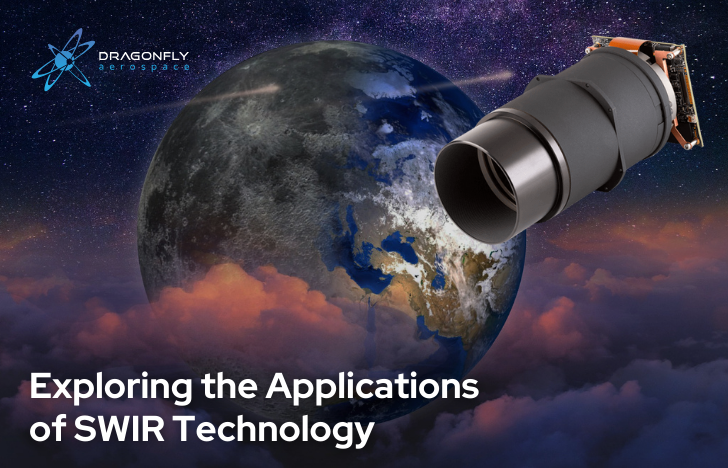
Cutting-edge technology continues to serve as a guiding light in the vast expanse of outer space, where humanity’s thirst for new understanding constantly pushes the boundaries of what we can perceive. Short-wave infrared (SWIR) technology allows us to see what the naked eye cannot and peer beyond the limitations of visible light.
SWIR technology explained
The fundamental principle behind SWIR imaging lies in the interaction between light and matter. SWIR cameras operate in a wavelength range typically spanning from 900 – 1700 nm (nanometres), just beyond the visible spectrum.
Unlike visible light, which is absorbed or scattered by various substances, SWIR wavelengths can penetrate through certain materials which would otherwise reflect light, providing remarkable insights where visible information was already lost. This technology can detect and capture light reflected or emitted by objects, providing valuable insights in fields as vast as precision agriculture and surveillance — when used in Earth observation — and even medical imaging.
With SWIR camera technology, scientists and researchers can uncover hidden details and patterns previously invisible to the human eye, deepening our understanding of our planet.
What are the applications of SWIR Technology?
Precision Agriculture
Crop health monitoring
SWIR cameras act like health checkers for crops, detecting early signs of stress, disease, and nutrient shortages. By capturing spectral information beyond visible light, these cameras offer farmers invaluable insights to develop crop management practices and substantially capitalise on yields.
Soil composition analysis
With SWIR imaging, farmers can analyse the soil’s makeup to better understand soil composition, moisture levels, and nutrient distribution to tailor specific crop needs. This agriculture technique allows farmers to make informed decisions regarding irrigation, fertilisation, and soil management, enhancing overall agricultural productivity.
Water stress detection
SWIR cameras can pinpoint areas where crops are thirsty and identify water stress patterns, allowing for targeted irrigation strategies that conserve water resources and mitigate environmental impact. Farmers can implement localised solutions to optimise water utilisation and promote crop resilience in drought-prone regions by determining water scarcity or inefficient usage.
Identifying nutrition deficiencies
By highlighting where crops lack essential nutrients, SWIR cameras can guide farmers to implement precise fertilisation regimes that address specific deficiencies and improve nutrient uptake. This targeted approach reduces fertiliser wastage, reduces environmental pollution, and improves overall crop quality and yield.
Precision agriculture practices
With SWIR cameras, farmers can fine-tune their farming techniques using real-time insights into crop health, soil conditions, and environmental factors. By integrating SWIR data with advanced analytics and precision farming technologies, farmers can apply management strategies that boost supply allocation, minimise inputs, and increase returns.
Disaster Management and Response
Early warning systems
By continuously monitoring at-risk areas from space, SWIR sensors can detect early indicators of impending natural disasters, such as floods, wildfires, landslides, and volcanic eruptions. This early detection enables authorities to issue timely warnings, evacuate vulnerable populations, and implement measures to minimise the impact of potential disasters.
Disaster impact assessment
Following a disaster event, SWIR remote sensing data provides critical information for assessing the extent and severity of damage to affected areas. Using high-resolution imagery, SWIR sensors can assess damage and identify destruction areas, infrastructure damage, and population displacement. This information helps emergency responders prioritise response efforts, allocate resources effectively, and coordinate rescue and relief operations.
Search and rescue operations
SWIR technology helps search and rescue teams locate survivors in disaster-affected areas. Potential survivors trapped in collapsed buildings, stranded in remote locations, or lost at sea can be detected from space using thermal signatures and human activity patterns. This real-time information guides search and rescue efforts, optimising the deployment of rescue teams, aerial assets, and medical supplies to maximise the chances of survival.
Environmental monitoring
SWIR remote sensing is instrumental in monitoring environmental changes triggered by disasters, such as oil spills, chemical leaks, or ecosystem degradation. Following a disaster event, multispectral imagery can show changes in water quality, vegetation health, and land fluctuations. This environmental monitoring aids the long-term resilience and sustainability of affected ecosystems.
Assessing infrastructure damage
By analysing high-resolution SWIR imagery, authorities can assess structural integrity, identify potential hazards, and prioritise repairs and reconstruction efforts for buildings, roads, bridges, and critical lifeline structures. This assessment helps restore essential services, ensures public safety, and expedites the recovery and rebuilding process.
Scientific Research
Space exploration
SWIR technology is indispensable for astronomers and astrophysicists studying the cosmos, enabling the observation and analysis of celestial objects, phenomena, and events beyond the visible spectrum. Whether deployed aboard space telescopes, observatories, or planetary probes, SWIR cameras capture high-resolution images and data, shedding light on the origins, evolution, and dynamics of stars, galaxies, and the universe.
Distant galaxy imaging
SWIR cameras are like cosmic photographers, capturing stunning images of distant galaxies and stars. This makes them the ideal instruments for studying distant galaxies, star clusters, and cosmic structures, offering unique insights into the formation, evolution, and composition of the universe. By detecting infrared emissions, SWIR cameras allow astronomers and cosmologists to witness the wonders of galaxies millions of light-years away.
From the vibrancy of agricultural fields to the vast expanse of the cosmos, SWIR imaging technology serves as a beacon of discovery, guiding us through uncharted territories and shedding light on the mysteries of our existence. As we continue to harness their potential, these remarkable devices will undoubtedly shape the future of technology and our understanding of our world and the universe.



